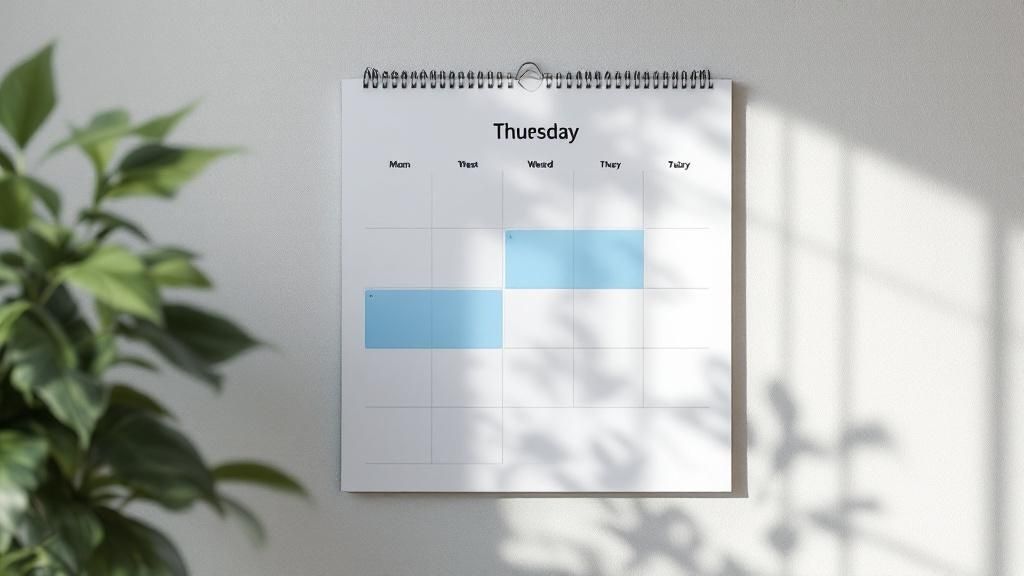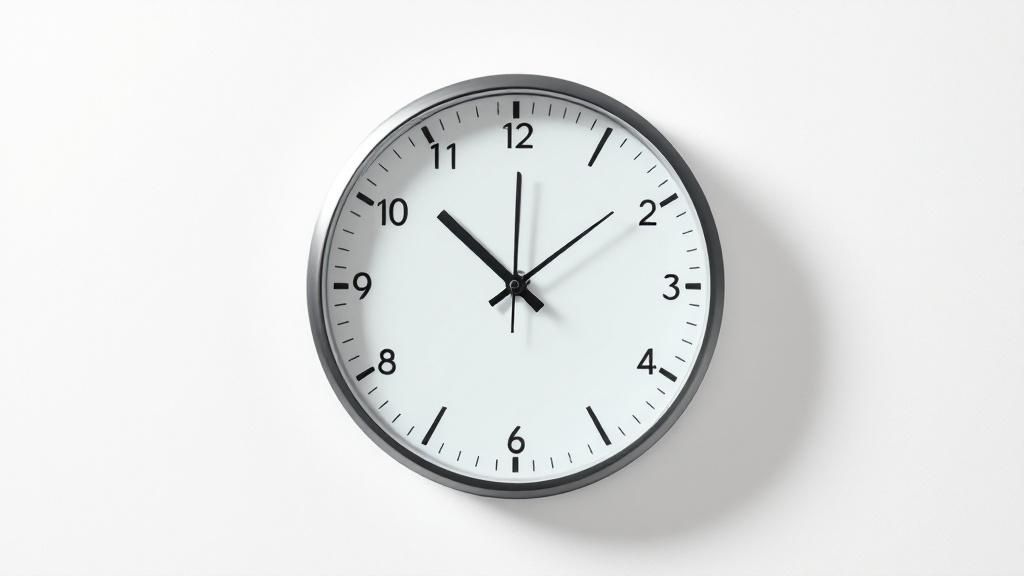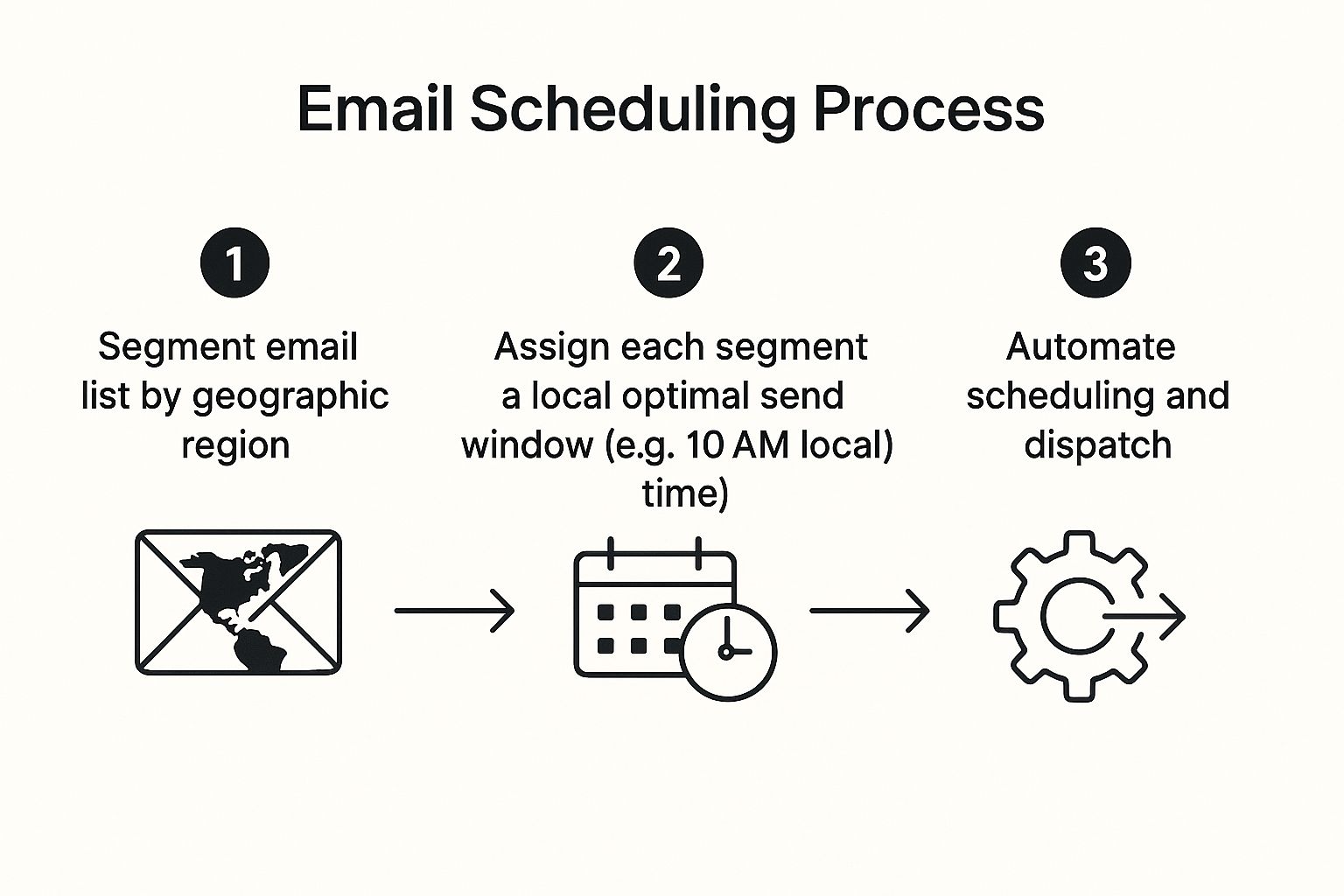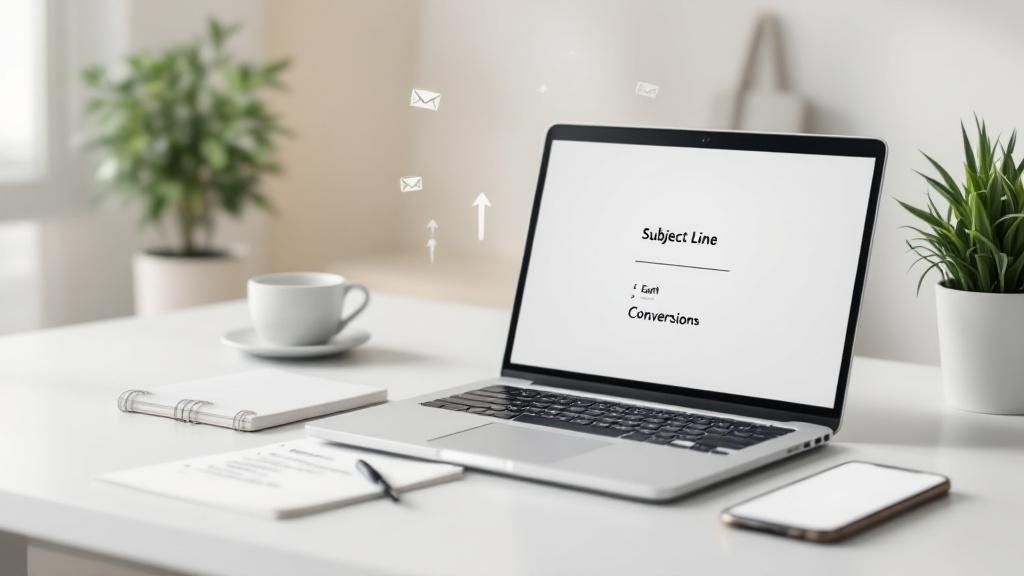Unlocking the Power of Perfect Timing
Want to know the best time to send sales emails and boost your open and response rates? This listicle reveals six proven strategies to optimize your outreach and accelerate pipeline growth. Discover how targeting specific days and times, personalizing to recipient time zones, A/B testing, and leveraging industry-specific and behavioral triggers can dramatically improve your sales email performance. Applying these techniques will help you connect with prospects when they're most receptive, leading to more conversions and closed deals.
1. Tuesday Through Thursday Window Targeting
Finding the best time to send sales emails can feel like searching for a needle in a haystack. With overflowing inboxes and dwindling attention spans, cutting through the noise and landing in front of the right eyes at the right time is crucial. That's where the Tuesday Through Thursday Window Targeting strategy comes in. This approach focuses on leveraging the mid-week period – Tuesday, Wednesday, and Thursday – to send your sales emails, capitalizing on a time when recipients are generally more engaged and less overwhelmed compared to the Monday catch-up or Friday wind-down periods.

This strategy works on the principle that people settle into their work routine by Tuesday. Monday is often dedicated to catching up after the weekend, sorting through a backlog of emails, and planning the week ahead. By Tuesday, recipients are more likely to be in a productive work mindset, open to new information, and actively engaged with their inbox. As the week progresses towards Thursday, this focus remains relatively consistent. Friday then marks the transition into the weekend, where attention shifts away from work-related tasks. By focusing on this mid-week window, you significantly increase the likelihood of your email being opened, read, and acted upon.
Research consistently backs up the effectiveness of this approach. Numerous studies from reputable sources demonstrate that Tuesday through Thursday sees the highest open and response rates for B2B sales communications. For instance, HubSpot’s analysis has shown that Tuesday emails boast an 18% higher open rate compared to other days. Salesforce has also reported peak B2B engagement on Wednesday mornings. Similarly, Mailchimp data consistently shows Tuesday-Thursday outperforming other days in terms of open and click-through rates. These findings highlight the power of targeting the mid-week window for optimal email performance.
The benefits of adopting Tuesday Through Thursday Window Targeting are substantial. You can expect consistently higher engagement rates, often 15-20% better than Monday or Friday. Your emails face less competition from the sheer volume of messages flooding inboxes on Mondays. Furthermore, recipients are more likely to be in a productive work mindset, increasing the chance they will dedicate the necessary time and attention to your message. This also creates a more favorable environment for scheduling follow-up meetings, as recipients are actively planning their work week.
However, like any strategy, Tuesday Through Thursday Window Targeting has its limitations. The very popularity of this approach means you'll be competing with other marketers using the same tactic. While it is effective for many B2B sectors, it may not be universally applicable across all industries or global audiences. Finally, implementing this strategy requires consistent scheduling discipline to maintain a regular cadence of outreach.
When and why should you use this approach?
This strategy is particularly well-suited for B2B sales professionals, freelancers, small to medium-sized businesses, marketing and lead generation agencies, sales operations managers, and even enterprise organizations seeking to optimize their outreach efforts. If you're struggling to cut through the noise and improve your email engagement metrics, focusing on the Tuesday through Thursday window offers a proven method for increasing open rates, response rates, and ultimately, conversions.
Tips for Effective Implementation:
- Test and refine: Don’t blindly follow the Tuesday-Thursday rule. Test your specific audience, as industry patterns may vary.
- Avoid holidays and busy periods: Be mindful of major holidays and industry-specific busy periods, adjusting your sending schedule accordingly.
- Consider time zones: For global campaigns, factor in your recipient’s time zone to ensure your emails arrive during optimal business hours.
- Track your data: Continuously monitor your email performance over several months to confirm patterns and refine your strategy.
By understanding the principles behind Tuesday Through Thursday Window Targeting and implementing the provided tips, you can significantly enhance your email outreach effectiveness and drive better results for your sales efforts. Remember, consistent testing and refinement are key to maximizing the impact of this strategy for your specific audience.
2. 10 AM to 2 PM Peak Performance Window
The 10 AM to 2 PM window represents a prime opportunity for sending sales emails, capitalizing on the natural rhythms of the workday and maximizing the chances of your message cutting through the noise. This period leverages the psychological and behavioral patterns of business professionals, who tend to be most alert, focused, and responsive during the late morning and early afternoon hours. This sweet spot captures recipients after they’ve dealt with the initial flurry of urgent morning tasks but before the inevitable afternoon energy dip sets in, significantly increasing the likelihood of email engagement and a positive response.

This approach aligns with the natural energy and attention cycles of most professionals. The early morning rush is often dedicated to catching up on overnight developments, prioritizing tasks, and responding to urgent requests. Similarly, the late afternoon is frequently characterized by declining energy levels and a shift in focus towards wrapping up the day's work. The 10 AM to 2 PM window neatly avoids both these less-than-ideal periods. Furthermore, this timeframe typically aligns with the optimal decision-making window for many professionals. They've had time to process information, consult colleagues if necessary, and are more likely to engage with proposals or offers. This timing is also generally compatible with most business schedules globally, making it a versatile strategy for reaching diverse audiences.
The benefits of adhering to this window are supported by data. Studies by leading email marketing platforms like GetResponse have shown that sending emails around 10 AM can result in significantly higher open rates – as much as 23% higher compared to early morning sends. Not only do open rates increase, but the quality of responses and engagement also tends to be better. This is likely because recipients have already cleared their inbox of urgent morning emails and have the mental bandwidth to engage with your message more thoughtfully. Campaign Monitor data further strengthens this argument, indicating 2 PM as a particularly optimal time for SaaS sales emails. Constant Contact research also confirms the mid-day superiority for email marketing across various industries. These findings underscore the effectiveness of leveraging this peak performance window.
While this timeframe offers significant advantages, it’s essential to be aware of potential drawbacks. The most obvious is the potential conflict with lunch hours, typically falling between 12 PM and 1 PM. Sending emails during this period can lead to your message being overlooked or buried under a post-lunch influx of emails. Another challenge is the increased email volume from competitors vying for the same attention during these peak hours. Finally, precise timing across different time zones requires careful planning, especially for businesses operating internationally. This often necessitates the use of email scheduling tools to ensure your messages land in the recipient’s inbox at the optimal time, regardless of their location.
To maximize your success with the 10 AM to 2 PM strategy, consider the following tips: Avoid the 12-1 PM lunch hour dead zone. Scheduling sends for 10:15 AM can be a strategic move, allowing your email to land after the initial morning email clearing and increasing its visibility. Utilize email scheduling tools to consistently hit the optimal windows across different time zones. This automation eliminates the need for manual calculations and ensures your messages reach the right people at the right time. Finally, A/B testing different times within this window, such as 11 AM versus 1 PM, can provide valuable insights into your specific audience’s behavior and help you fine-tune your sending strategy for even better results. This method, popularized by the research teams at Campaign Monitor, GetResponse, and CoSchedule, has proven to be a highly effective strategy for optimizing sales email performance. By understanding the nuances of this approach and implementing these practical tips, you can significantly improve your open rates, engagement, and ultimately, your sales conversions.
3. Recipient Time Zone Personalization
In the quest to find the best time to send sales emails, recipient time zone personalization emerges as a powerful strategy. This method involves segmenting your email lists based on recipients' geographic locations and scheduling emails to arrive at the optimal time in their local time zone, rather than using a single send time for everyone. This ensures your message lands in their inbox when they are most likely to be active and engaged, maximizing your chances of grabbing their attention, regardless of where they are in the world. This approach is crucial in today's interconnected global marketplace, where a one-size-fits-all approach to email marketing simply won't cut it.
Why does this deserve a spot on the “best time to send sales emails” list? Consider this: opening an email at 2 AM is unlikely to lead to a conversion. By respecting your recipient's local business hours and daily rhythms, you demonstrate consideration and increase the likelihood of your email being read and acted upon. This translates to higher open rates, click-through rates, and ultimately, conversions.
Recipient time zone personalization offers several key features: geographic segmentation of email lists, the ability to set multiple send times for single campaigns, local relevance and timing optimization, and a more tailored user experience. However, it requires sophisticated email platform capabilities.
Pros:
- Improved Engagement: Studies show that time zone personalization can improve engagement rates by up to 30%.
- Enhanced User Experience: Delivering emails at a convenient time shows respect for the recipient and enhances their overall experience with your brand.
- Competitive Edge: In global markets, this tactic provides a significant competitive advantage by allowing you to connect with prospects at the most opportune moments.
- Respect for Business Hours: Aligning your send times with local business hours increases the chance of your email being read during work hours.
Cons:
- Advanced Tools Required: Implementing time zone personalization requires access to advanced email marketing platforms with these capabilities.
- Increased Complexity: Setting up and managing multiple send times adds complexity to your campaign workflows.
- Potential for Errors: Incorrect time zone calculations can lead to emails being sent at the wrong time, negating the benefits.
- Diluted Campaign Momentum: Staggered sending can sometimes make it harder to track real-time campaign performance and capitalize on early momentum.
Several companies have successfully leveraged time zone personalization. Uber optimized their location-based email campaigns, increasing bookings by 25%. Similarly, Airbnb saw improved host response rates by targeting emails based on time zones. Even Microsoft uses local time optimization for their global product launch emails.
The following infographic illustrates the three core steps involved in implementing time zone personalization for your sales emails:

This infographic visualizes the process of personalizing email send times by first segmenting your email list by geographic region, then assigning each segment an optimal send time based on their local time (e.g., 10 AM), and finally, automating the scheduling and dispatch of these emails. As the infographic demonstrates, a streamlined, automated approach allows you to reach the right people at the right time, maximizing the impact of your outreach.
Tips for Implementation:
- Automate Segmentation: Utilize IP-based location data for automatic segmentation of your email lists.
- Create Flexible Templates: Design email templates that adapt well across different time zones and cultural contexts.
- Account for Daylight Saving: Ensure your system accounts for daylight saving time changes to avoid sending emails at the wrong hour.
- Test and Refine: Test your time zone personalization strategy with smaller segments before full deployment to identify any issues and optimize performance.
Popularized by teams like Sendgrid's marketing automation team and incorporated into Marketo's global campaign strategies, time zone personalization has become a staple for international SaaS companies like Atlassian. This approach is particularly beneficial for businesses targeting audiences across multiple time zones, as it ensures that emails are delivered at the most opportune times for each recipient. Learn more about Recipient Time Zone Personalization. By implementing these strategies, you can significantly improve the effectiveness of your sales email campaigns and achieve a higher return on your marketing investment.
4. A/B Testing for Send Time Optimization
Finding the best time to send sales emails can feel like searching for a needle in a haystack. Generic advice might point you towards Tuesday mornings or Wednesday afternoons, but what works for one business might not work for another. That's where the power of A/B testing for send time optimization comes into play. This data-driven approach empowers you to discover the precise moments when your specific audience is most receptive to your message, leading to higher open rates, click-through rates, and ultimately, conversions.
A/B testing for send time optimization involves systematically testing different send times with statistically significant sample sizes. Instead of relying on industry benchmarks or guesswork, you’re conducting a controlled experiment to see what resonates best with your audience. This eliminates assumptions and provides concrete evidence of what truly works. Think of it as a personalized roadmap to email success, tailored specifically to your audience's behavior.
Here's how it works: you divide your email list into two or more groups (A, B, etc.). Each group receives the same email, but at a different time. For example, Group A might receive the email at 10 AM on Tuesday, while Group B receives it at 2 PM on Tuesday. By analyzing the performance metrics (opens, clicks, conversions) of each group, you can determine which send time yielded better results.
This method is particularly crucial for achieving optimal results with your best time to send sales emails strategy. Instead of relying on generic advice, you’re tailoring your approach based on real data from your audience.
The benefits of this data-driven approach are numerous. It provides concrete data specific to your audience, eliminates assumptions and generalizations, allows for continuous improvement, and can even reveal unexpected optimal send times. For example, Groove HQ discovered their audience preferred 2 PM sends over the commonly recommended 10 AM, dramatically improving their engagement. Similarly, Buffer found their social media audience responded better to Thursday 3 PM emails, while ConvertKit discovered their creator economy audience preferred weekend sends, defying typical weekday norms.
However, A/B testing isn’t without its challenges. It requires significant sample sizes for statistical validity (at least 1,000 per group is a good starting point). It's also a time-intensive process, often requiring 2-4 weeks of testing to gather reliable data. Results can change over time due to shifting audience behavior or external factors, necessitating periodic retesting. Finally, a basic understanding of statistical significance is necessary to properly interpret the results.
To get started with A/B testing for send time optimization, consider these actionable tips:
- Test one variable at a time: Focus on either day or time, not both simultaneously. This isolates the impact of each variable and provides clearer insights.
- Ensure sufficient sample sizes: Aim for at least 1,000 recipients per test group. Larger sample sizes provide more statistically significant results.
- Run tests for an adequate duration: Test for a minimum of 2-4 weeks to account for variations in daily and weekly email activity.
- Use statistical significance calculators: Several online tools can help you determine if the differences in your results are statistically significant, ensuring the changes aren't due to random chance.
- Continuously optimize: Regularly revisit your send times and conduct further A/B tests to account for changes in audience behavior and maintain optimal performance.
Learn more about A/B Testing for Send Time Optimization
Gathering feedback is crucial for optimizing your email strategy. Knowing what to ask and when can significantly improve your results. For practical tips and templates, consider this resource on how to ask for testimonials which provides proven examples from Testimonial Donut.
A/B testing, popularized by the growth hacking community and championed by data-driven marketing pioneers like Neil Patel, is a crucial tool for optimizing the best time to send sales emails. Marketing automation platforms like Marketo offer built-in features to facilitate this process. By embracing this data-driven methodology, you can move beyond generalizations and discover the optimal send times that truly resonate with your audience, leading to increased engagement and ultimately, greater sales success.
5. Industry-Specific Timing Strategies
Finding the best time to send sales emails isn't a one-size-fits-all endeavor. While general best practices offer a solid foundation, maximizing your email engagement hinges on recognizing the unique rhythms of your target industry. This is where industry-specific timing strategies come into play. This approach acknowledges that different industries operate on distinct schedules, experience varying peak seasons, and maintain unique communication patterns, all of which significantly impact how and when professionals engage with their inboxes. Understanding these nuances is crucial for optimizing your email outreach and improving your sales effectiveness.
Industry-specific timing strategies involve researching and adapting your email send times based on the typical behaviors and workflows within your target sector. This means moving beyond generic advice and delving into the specifics of how professionals in your target vertical operate. For instance, a healthcare professional's email habits will likely differ dramatically from those of a retail manager or a financial services executive. By tailoring your send times to align with these industry-specific patterns, you increase the likelihood of your emails being seen, read, and acted upon.
This targeted approach offers several key features that contribute to its effectiveness. These include:
- Industry Behavior Pattern Recognition: This involves understanding the typical workday, communication preferences, and information consumption habits within a specific industry.
- Sector-Specific Scheduling Adaptations: This focuses on tailoring your email send times to coincide with when your target audience is most likely to be receptive to your message.
- Professional Workflow Consideration: This takes into account the daily tasks, responsibilities, and decision-making processes prevalent in a specific industry.
- Vertical Market Optimization: This aims to maximize the impact of your email campaigns by aligning your outreach with the specific dynamics of your target market.
The benefits of implementing industry-specific timing strategies are manifold. By demonstrating a deep understanding of your recipient's business and respecting their time, you foster trust and build stronger relationships. This translates to:
- Higher relevance and engagement rates: Emails sent at opportune times are more likely to resonate with recipients, leading to increased open and click-through rates.
- Demonstrates understanding of the recipient's business: Tailoring your outreach shows you’ve done your homework, which can significantly improve your credibility and build rapport.
- Reduces unsubscribe rates: Avoiding bombarding prospects with emails during inconvenient times minimizes frustration and reduces the likelihood of them opting out of your communications.
- Improves overall sales effectiveness: By increasing engagement and fostering positive relationships, you ultimately enhance your chances of converting leads into paying customers.
However, this approach isn't without its challenges:
- Requires extensive industry research: Gaining a deep understanding of industry-specific behaviors requires dedicated research and analysis.
- More complex segmentation and campaign management: Implementing tailored send times often necessitates more granular segmentation and more intricate campaign management.
- May not account for individual company variations: While industry trends provide valuable insights, they may not perfectly capture the nuances of every individual company within that sector.
- Assumptions may become outdated: Industry trends can shift over time, so it’s crucial to continuously monitor and adapt your strategies accordingly.
Consider these examples of successful industry-specific email timing:
- Healthcare: Emails often perform better early morning (6-8 AM) before rounds begin or late evening after patient care has concluded.
- Restaurant Industry: Mondays and Tuesdays, typically slower days used for planning and administrative tasks, can be ideal for reaching restaurant managers.
- Education Sector: Aligning your email outreach with the academic calendar, avoiding holidays and exam periods, can significantly improve engagement.
- Finance Industry: Steering clear of month-end and quarter-end closing periods, when finance professionals are extremely busy, is crucial for maximizing your message's impact.
To effectively implement industry-specific timing strategies, consider these actionable tips:
- Research industry publications for workflow insights: Trade journals, industry blogs, and professional forums can provide valuable information about the typical workday and communication patterns within your target sector.
- Survey your existing customers about their email habits: Direct feedback from your current clients can provide valuable insights into the best times to reach them and their peers.
- Monitor industry events and busy seasons: Be aware of major conferences, trade shows, and peak periods within your target industry to avoid sending emails during these hectic times.
- Create industry-specific email calendars: Develop dedicated email schedules tailored to the specific nuances of each vertical you target.
Learn more about Industry-Specific Timing Strategies
Industry-specific timing strategies have been widely adopted and popularized by vertical SaaS companies, industry-specific marketing agencies, and B2B sales development representatives. These groups understand the power of personalized outreach and recognize that aligning their communication with the specific needs and behaviors of their target audience is key to achieving optimal results. By taking the time to understand the unique characteristics of your target industry and tailoring your email strategy accordingly, you can significantly enhance your engagement rates, build stronger relationships, and ultimately drive more sales. This approach is crucial for anyone seeking to optimize their email outreach, making it a deserving addition to any list of best practices for sending sales emails.
6. Behavioral Trigger-Based Timing
Finding the best time to send sales emails can feel like a guessing game. While general best practices offer a starting point, behavioral trigger-based timing transcends the limitations of calendar-based scheduling and provides a significantly more personalized and effective approach. This method uses recipient actions and engagement patterns to pinpoint the optimal send times, leading to higher open and conversion rates. Instead of blasting emails at predetermined times, this strategy observes when individuals typically open emails, browse websites, or interact with your content, and then schedules future emails to align with these personalized activity patterns. This allows your message to arrive when the recipient is most receptive, maximizing its impact.

Behavioral trigger-based timing relies on several key features. It involves tracking individual behavior patterns, such as email opens, clicks, website visits, and content engagement. This data is then used to dynamically adjust send times, constantly optimizing for peak engagement. By analyzing engagement history, the system learns and adapts to the individual’s evolving preferences. This personalized timing optimization results in a highly targeted approach, drastically improving the chances of your message being seen and acted upon.
This approach offers several significant advantages. Its highly personalized nature resonates with recipients, making them feel understood and valued. Studies have shown that this method can achieve 40% or higher open rates compared to traditional methods. Furthermore, it adapts to changing individual patterns, ensuring continued relevance even as user behavior evolves. This maximizes relevance and timing, putting your message front and center when it matters most.
However, implementing behavioral trigger-based timing also presents some challenges. It requires sophisticated marketing automation software capable of tracking and analyzing individual behavior. A substantial amount of historical data is needed to build accurate individual profiles, which can be a hurdle for new or inactive contacts. The setup and maintenance of such a system can be complex, requiring specialized expertise.
Despite these challenges, the potential benefits make behavioral trigger-based timing a powerful tool, especially for established businesses with sufficient data. Think about how Netflix sends personalized recommendations based on your viewing history, or how Amazon times promotional emails to coincide with your browsing behavior. LinkedIn also uses this approach to optimize connection request notifications, while SaaS companies time upgrade emails based on usage patterns. These examples illustrate the effectiveness of this strategy across various industries.
So, how can you leverage behavioral trigger-based timing for your sales emails? Here are some actionable tips:
- Track Everything: Diligently track email opens, clicks, website visits, and any other relevant interactions. This data forms the foundation of your behavioral analysis.
- Invest in the Right Tools: Utilize marketing automation platforms that offer robust behavioral trigger functionalities. Explore options like Pardot and other leading customer success management platforms.
- Start Broad, Then Refine: Begin by identifying broader patterns within your audience segments before diving into individual optimization. This allows you to establish a baseline and gradually refine your targeting.
- Hybrid Approach: Combine behavioral trigger-based timing with traditional timing strategies as a fallback, especially for new contacts with limited behavioral data.
Behavioral trigger-based timing deserves a prominent place on this list of best times to send sales emails because it moves beyond generic scheduling and embraces the power of personalization. While it requires more sophisticated setup and data analysis, the potential for significantly increased engagement and conversion rates makes it an invaluable asset for businesses seeking to optimize their email marketing efforts. By understanding individual preferences and aligning your outreach accordingly, you can drastically improve the effectiveness of your sales emails and achieve superior results. For established businesses with the resources to invest in marketing automation and data analysis, this approach is a game-changer in the quest for finding the best time to send sales emails.
6 Best Practices Send Time Comparison
| Best Practice | Implementation Complexity 🔄 | Resource Requirements ⚡ | Expected Outcomes 📊 | Ideal Use Cases 💡 | Key Advantages ⭐ |
|---|---|---|---|---|---|
| Tuesday Through Thursday Window Targeting | Low to Moderate: Requires consistent scheduling and discipline | Moderate: Basic email platform scheduling and monitoring | Improved open and response rates by 15-20% | B2B sales communications, mid-week engagement | Higher engagement during productive work mindset; less inbox competition |
| 10 AM to 2 PM Peak Performance Window | Moderate: Needs precise timing and time zone management | Moderate: Scheduling tools with fine timing controls | 23% higher open rates, better quality engagement | Businesses targeting global audiences during mid-day hours | Aligns with natural energy cycles; allows same-day follow-ups |
| Recipient Time Zone Personalization | High: Complex segmentation and multiple send times | High: Advanced email platforms with geographic and scheduling capabilities | Up to 30% improvement in engagement | Global campaigns, diverse geographic audiences | Respects local business hours; enhances global relevance |
| A/B Testing for Send Time Optimization | High: Requires statistical analysis, continuous testing | Moderate to High: Large sample sizes, testing tools | Audience-specific optimal send times, data-driven gains | Businesses seeking precise send time optimization | Eliminates assumptions; reveals unexpected optimal times |
| Industry-Specific Timing Strategies | Moderate to High: Needs industry research and segmentation | Moderate: Research resources and segmented campaigns | Increased relevance and engagement; reduced unsubscribes | Vertical markets with distinct workflows | Shows industry understanding; improves sales effectiveness |
| Behavioral Trigger-Based Timing | Very High: Sophisticated automation and data integration | Very High: Marketing automation, extensive historical data | 40%+ higher open rates; dynamically personalized timing | Personalized marketing; high-value individual targeting | Maximizes personalization; adapts to individual behavior patterns |
Mastering Your Email Timing Strategy with Salesloop.io
Finding the best time to send sales emails isn't about luck; it's about strategy. We've covered six key tactics, from focusing on the Tuesday through Thursday window and the 10 AM to 2 PM peak performance timeframe, to the importance of recipient time zone personalization and the power of A/B testing. Furthermore, understanding industry-specific nuances and leveraging behavioral trigger-based timing can significantly refine your approach. Mastering these concepts empowers you to move beyond guesswork and connect with your prospects when they're most receptive, dramatically increasing open and click-through rates, leading to more conversions and ultimately, boosting your bottom line. Whether you're a solo sales professional or part of a large enterprise, optimizing your email send times is crucial for maximizing your outreach effectiveness.
By implementing these strategies, you can transform your email outreach from a hit-or-miss tactic to a predictable driver of sales growth. Remember, the best time to send sales emails is when your audience is most likely to engage. Salesloop.io makes pinpointing and targeting those optimal send times effortless. Ready to take your sales email strategy to the next level and see a real impact on your pipeline? Visit Salesloop.io today and discover how its advanced features can automate and optimize your outreach for maximum results.





